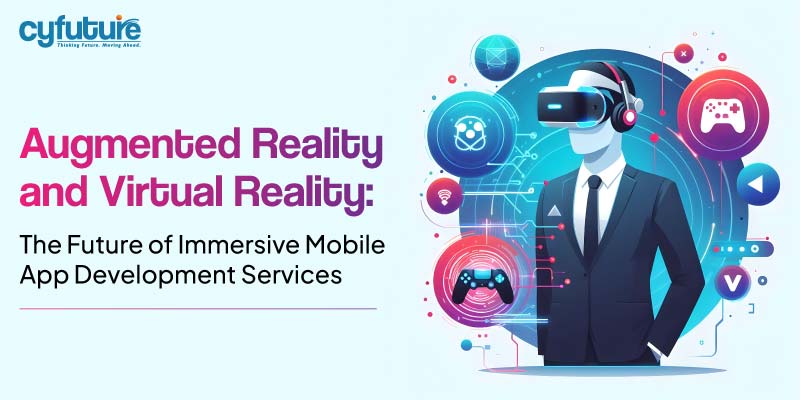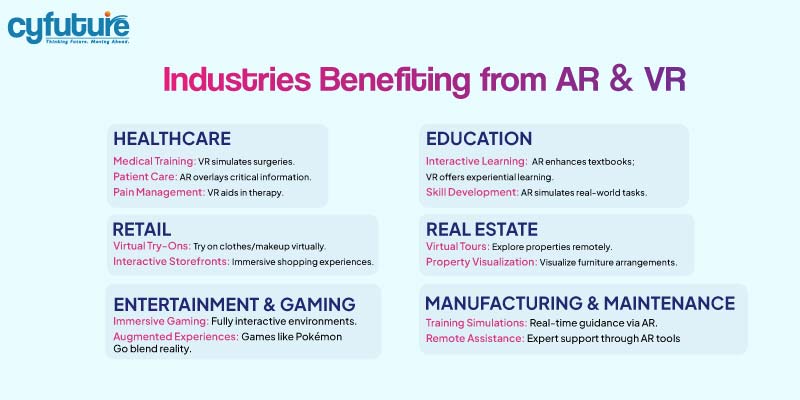-
Get Cloud GPU Server - Register Now!
Toggle navigation

Technology improvement is gaining speed, which reshapes our lives. Two such examples, AR and VR, have revolutionized mobile app development services. Therefore, with the help of expanding better and more practical experiences, not only is the satisfaction of the users enhanced, but the development of AR and VR also transforms several industrial sectors.
In recent decades, technology has brought about a dramatic change in the world of business. These are the AR/ VR technology trends that will happen in the subsequent years, and they will ensure that any businessman looking for professional assistance invests in this area to capture a share in the expected market size of USD 1274.4 billion in 2030.
In this post, we’ll peek at upcoming AR and VR trends. They’ll shape mobile app development’s future. Together, we’ll explore AR and VR’s potential uses, opportunities, and hurdles.
Augmented Reality, or AR for short, is tech that puts digital details like pictures, noises, or words over what’s really there. AR is like putting computer-made pictures or photos on top of a photograph from a real place. It helps users add things to where they’re really at. Some of the most common cases are games like Pokémon Go, where augmented reality places game characters in a real-world environment, or interior design apps such as IKEA Place, which puts furniture directly into a user’s house.
When it comes to AR, most people consider gaming, and there is some logic in this regard, given that the VR gaming market is worth $1. 1 billion. Today, the overall global market for VR is estimated to be $7. 72 billion in 2015, projected to rise to $26. 9 billion by 2027.
Virtual Reality (VR) creates an entirely artificial world in which the user is removed from the actual environment of the real world. People participate in VR activities by putting them inside a headset that offers them a full-frontal view of a computer-generated environment. VR is used in different fields: gaming, training simulation, virtual tourism, and therapy.
Today, more than 171 million people use VR. In the United States alone, there are 50.2 million VR users, which is approximately 15 % of the entire population of the United States. But there are even more AR users in the U.S., with statistics showing that 83.7 use this technology.
The rise in processing power in mobile devices also boosts their capacity to run different apps. This increase creates a greater need for AR and VR apps. Analyzing the information presented in the report, 75% of large-scale companies using VR/AR technologies in their business received a 10% increase in their operations. These are some of the factors that have made the growth of this industry possible.
The adoption of AR and VR in mobile app development services has numerous benefits.
More and more, Augmented Reality (AR) and Virtual Reality (VR) are increasing. They’re being used across different industry sectors. Their job? To boost functions and make dealing with customers better. Here’s a list of industries that are reaping big through the use of such immersive technologies:

| Metric | Augmented Reality (AR) | Virtual Reality (VR) |
| Immersion Level | Partially immersive – overlays digital content onto the real world | Fully immersive – transports users to a completely simulated environment |
| Interaction | Allows interaction with both virtual and physical objects | Restricts interaction to only the virtual environment, often requiring specialized controllers |
| Hardware Requirements | Can be accessed through smartphones, tablets, or AR glasses | Requires dedicated VR headsets with controllers and other tracking devices |
| Awareness | Lower awareness levels, especially among older demographics and females | Higher awareness levels across age groups and genders |
| Engagement | Mainly clustered around the 16-34 age group, with lower engagement in older demographics | Engagement follows a similar pattern to awareness, with the highest usage in the 16-34 age group |
| Mainstream Potential | Among those aware of both AR and VR, 50% believe AR has the highest likelihood of going mainstream first | 47% of recent AR/VR users believe VR has the strongest chance of hitting the mainstream first |
| Applications Beyond Gaming | Has a more immediate opportunity to prove its value in everyday life scenarios like shopping, navigation, and social media | Primarily seen as a gaming technology for now, with a need to expand into other high-exposure consumer categories |
Let’s look at the main expenses that groups might face when they start using Augmented Reality (AR) and Virtual Reality (VR) in Indian businesses. This is measured in INR:
However, several issues need to be met when implementing AR and VR in app development services:
Immersive applications such as AR and VR entail high-end technologies that can support the systems. In this respect, it is necessary to note that not all mobile devices have the essential features, including high-resolution screens, new-generation processors, and specific sensors. This disadvantage requires the developer to adjust their application to work on different devices, constraining the audience that can engage with such experiences. As a result, ensuring compatibility across various hardware configurations becomes a critical challenge for developers.
AR and VR applications are not created overnight; they require massive time, money, and effort. Designing a high-quality, immersive environment entails a combination of graphic design, three-dimensional design, and user experience design. Moreover, the application and software required in the development process of AR/VR apps are costly and add to the cost of developing an app.
Creating efficient navigational interfaces for augmentation and virtual reality interfaces is challenging—the user balances between the digital and physical environment, resulting in usability problems. For example, users may struggle with finding the correct angle or distance to view AR content effectively. Also, the feeling of nausea or the uneasiness associated with motion sickness if they are not well worked on may be felt by the people in the Virtual Reality experiences. These are some of the factors that developers ought to examine to make delivery a smooth process which does not cause uneasiness.
Another major issue that needs to be resolved is providing high-quality, realistic, and relevant content for AR and VR applications. Information requires time, skills, and technologies to develop, and it can be thus costly to produce. In augmented reality applications, the content needs to correspond well to the real world, and in different virtual reality scenarios, the content needs to be engaging enough. This includes managing the size and resolution of digital assets to maintain performance without compromising quality.
AR and VR applications enhance traditional applications with graphics and interaction, consuming several hardware resources. Some of the problems that may arise from them include the slow rate at which the page loads, lagging, or even crashing in the worst-case scenario, which can only be prevented through proper optimization. To build responsive web designs, developers must use techniques such as caching, compression, and correct coding to guarantee the responsive functionality of the web design across devices with different resolutions while controlling battery usage efficiently.
Due to AR and VR applications’ interactive and immersive nature, these applications send and receive user information such as location, preferences, and patterns. Patient data and their information can risk theft or compromise if it is not well protected. It also means that developers must be concerned with features such as encryption, data storage, and protection to ensure that users’ data privacy is protected while meeting the provisions of data protection regulations.
More and more Augmented Reality (AR) and Virtual Reality (VR) gadgets are being used these days. But guess what? Many people don’t know why they’re awesome or how to use them! It is crucial to familiarise people with these technologies if use should be encouraged. However, this may be challenging due to fairly negative attitudes towards any new thing or refusal to download applications that need a lot of storage space or processing power.
It has raised many legal and ethical issues, such as ownership of the created content, copyright, responsibility, and users’ rights while incorporating digitized content into a more physical environment. To achieve those goals, developers must operate these technologies considering several challenges and risks, including legal ones associated with improper or damaging content shown by AR/VR applications.

The trend in the future of mobile app development services will witness several occurrences, such as the incorporation of AR and VR technologies. It is, therefore, easy to see why developers are inclined to get into the action. The growth trends are anticipated to show that app development services will generate more than $600 billion by 2025 and is not static.
With Augmented Reality and Virtual Reality on the rise, mobile app development services are set for a fresh wave of transformation. It’s all gearing up to usher in unprecedented experiences. With the advancement of technology and its availability, these developers have to incorporate the development of such innovations to sustain the competition in this booming market.
The opportunities of applying AR/VR in different industries should be considered based on their effectiveness, advantages, and some difficulties involved in their execution so that they can become quite helpful for increasing sales, attracting visitors, and gaining their trust. App development services are the future as it creates new possibilities for interacting with personalized content in everyday life.
All in all, integrating enhanced reality and virtual reality within mobile application development services are no longer an option; it is becoming essential for any business that wants to succeed in the technological world.